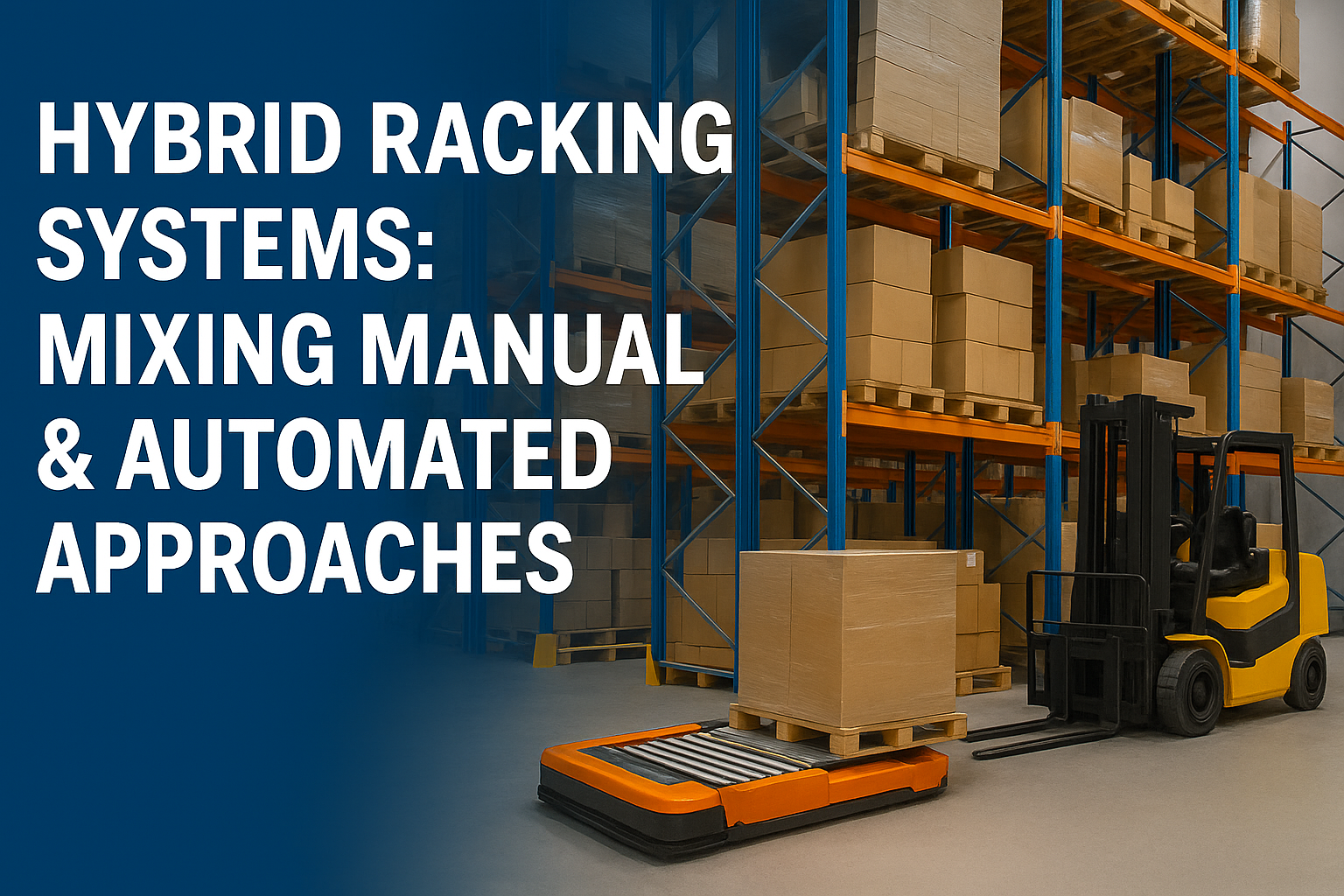
The Shift Toward Hybrid Racking in UAE Warehouses
The UAE has rapidly emerged as a logistics powerhouse, with Dubai, Abu Dhabi, and Sharjah leading the transformation of warehousing and supply chain operations. Companies here are investing heavily in innovative storage solutions to handle rising e-commerce demand, cold storage requirements, and distribution pressures. One trend gaining momentum is the adoption of hybrid racking systems in UAE warehouses, where manual racking integrates with automated systems to create a smart, flexible, and cost-effective storage setup.
Hybrid racking bridges the gap between full automation (which is expensive and rigid) and traditional manual systems (which are labor-intensive and slower). This balanced approach offers UAE companies a way to scale efficiently, while maintaining adaptability in fast-changing markets.
What Are Hybrid Racking Systems?
Hybrid racking systems combine traditional manual racks (selective pallet racking, drive-in, push-back) with automated tools such as conveyors, shuttle carts, stacker cranes, or robotic picking systems.
Instead of going fully manual or fully automated, hybrid solutions allow businesses to:
- Automate high-volume repetitive tasks.
- Retain manual flexibility for irregular or seasonal items.
- Reduce capital expenditure compared to fully automated warehouses.
This semi-automation model has become especially relevant in the UAE logistics sector, where businesses face diverse storage needs ranging from FMCG to pharma to cold chain operations.
Why UAE Warehouses Are Turning to Hybrid Racking
Several industry-specific factors make hybrid racking UAE a growing trend:
- Cost vs. Efficiency Balance
Full automation can cost millions of dirhams upfront. Hybrid racks offer incremental automation, letting businesses enjoy efficiency gains without overspending. - High Demand for Scalability
With e-commerce booming in Dubai and beyond, warehouses need systems that can quickly adapt to peak seasons. Hybrid setups allow expansion in stages. - Labor Market Dynamics
Manual labor is still crucial, but rising demand for speed means semi-automation fills the gap, reducing human error and increasing throughput. - UAE’s Logistics Hub Position
As a global hub, the UAE requires warehouses to manage diverse cargo (from electronics to perishable foods). Hybrid racking ensures flexibility across industries.
Key Benefits of Hybrid Racking Systems in UAE
1. Optimized Space Utilization
Hybrid racks combine dense storage solutions with automated movement, reducing wasted space and improving storage capacity.
2. Increased Throughput & Speed
Semi-automation tools such as pallet shuttles ensure faster handling, especially in high-volume operations.
3. Lower Capital Investment
Compared to full warehouse automation, hybrid solutions are budget-friendly while still boosting efficiency.
4. Flexibility in Operations
Manual sections handle irregular or seasonal items, while automated areas handle consistent, high-turnover products.
5. Reduced Error Rates
With automation assisting repetitive processes, picking accuracy improves, reducing costly mistakes.
6. Future-Proof Warehousing
Hybrid racking UAE solutions can scale gradually toward full automation, making them a long-term investment strategy.
Industries in UAE Benefiting from Hybrid Racking
Hybrid racking is not industry-specific. In fact, it has wide applications:
- E-commerce & Retail: Fast-moving SKUs benefit from automated picking, while seasonal goods remain in manual zones.
- Cold Storage & Food Distribution: Automated pallet shuttles reduce worker exposure to freezing conditions.
- Pharmaceuticals: Hybrid racks ensure precision handling while maintaining compliance with UAE health regulations.
- Automotive: Heavy parts stored manually, while smaller high-turnover items are picked via automation.
Challenges in Implementing Hybrid Racking in UAE
While the advantages are significant, businesses must also consider:
- Integration Costs: Automation tools need software and IT alignment.
- Training Needs: Staff must adapt to hybrid workflows.
- Maintenance: Automated components require upkeep and spare parts.
- Customization: Each UAE warehouse may need a tailored design.
Despite these challenges, most companies view hybrid systems as a practical compromise between tradition and innovation.
Future Outlook of Hybrid Racking in UAE
Given the UAE government’s strong focus on becoming a global logistics leader, the hybrid racking market is expected to expand. With Expo City Dubai promoting sustainable warehousing and the rise of smart warehouses in JAFZA and KIZAD, semi-automation will remain a preferred choice for businesses seeking growth without overwhelming capital expenditure.
Hybrid racks are more than just a storage solution they represent the future of adaptable logistics in the UAE.
FAQs: Hybrid Racking UAE
Q1. What makes hybrid racking systems different from traditional racks?
Hybrid systems blend manual racks with automation tools, offering speed, flexibility, and scalability in one solution.
Q2. Are hybrid racking systems cost-effective in the UAE?
Yes. Compared to full automation, they require less upfront investment and deliver faster ROI through efficiency improvements.
Q3. Which UAE industries benefit most from hybrid racks?
E-commerce, cold storage, retail, pharmaceuticals, and automotive sectors all leverage hybrid racking UAE solutions effectively.
Q4. Can hybrid racking be expanded to full automation later?
Absolutely. Hybrid systems are designed to scale up gradually, making future transitions smoother and less expensive.
Q5. Do hybrid racks work in cold storage warehouses in Dubai and Abu Dhabi?
Yes, especially when paired with pallet shuttles or conveyors, which reduce manual labor in low-temperature environments.